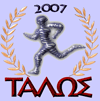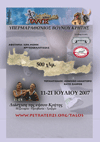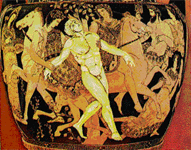|
A cupreous nail was wedged
in utmost his unique vein that began from the nape and led to
his ankle. His brassy body was kept live by the ichor, the Olympian
blood that flowed in his vein.
Origin
Various opinions exist for his
origin, which, upon an opinion, is related with the myth of Europe’s
kidnapping. The Jupiter kidnapped the beautiful girl of Aginora
from the Tyros or the Sedona, after he cheated her transformed
himself in a bull. He led her to the bridal bed under the shade
of a platan tree at Gortyna. Afterwards he offered her three gifts,
a dog that nothing could escape from him, a quiver with arrows
which could find their target and a cupreous giant, the protector
of Crete, called Talos. Also other opinions exist for his origin.
Apollodoros says that he was manufactured by Ifestos, the God
of fire and iron and he had offered him to King Minoa in order
to guard Crete. Other say that he is the son of Kritos, and that
the Kris was Jupiter’s and a nymph’s son. Still they say that
this giant was belonged in the human race of Copper Period. Finally,
for other he was Rodamanthys’ brother, third brother of Minoa
or dignitary in his service.
Role
According to Philosopher Plato, aside of Rodamanthos,
who was the guardian of the laws in the city, the King Minoa assigned
the same duty to Talos for the other regions of Crete. Indeed,
Talos passed three times a year from all the villages of Crete,
supervising the implementation of laws. He carried them everywhere
with him placed on his back, engraved in cupreous boards. Later
writers couldn’t believe that there was existed a cupreous person,
therefore they said that because he carried the plates he was
named Talos. Talos, according to the legend, was dowered with
such an amazing agility that allowed him to reach very rapidly
in all the points of Crete. They said also that he was winged.
He did not have arms but he was however capable to fight alone
with any fleet. He turned away, by throwing pieces of rocks towards
the foreigners who attempted to enter the island. And, if some
boat accomplished to reach the coasts, again Talos was the one
that did not leave the enemy to go ahead. He was used to enter
the fire and to burn his body. What was leaned by the glowing
metal, immediately it was burned. Thus, as he was glowing he was
approaching the enemies, he embraced them tightly and he was burning
them
Fairy tales
The legend of Talos was dear in Crete, as the hero was
dear himself, too. The residents of Festos put his engraved body
on the local coins. He is portrayed on them as young, naked and
with feathers in the shoulders. Thus, perhaps, they interpreted
his swiftness to anticipate to cover three times the day the island
of Crete and to protect them from hostile raids and the piratesTalos
was the brazen warder of Crete. Flesh or Bronze. Man or bull.
Some have said that Talos was son of Cres and father of Hephaestus.
But others affirm that he was a creature made of bronze, given
by Zeus to Europa, or by Hephaestus to Minos 2, to be the warder
of Crete; and whereas some have asserted that he was a brazen
man, others have said that he was a bull. Talos, yet others affirm,
was the last of a generation of men of bronze, sprung from the
ash-trees. Talos guarded Crete by running round the island three
times every day, and when intruders appeared he pelted them with
stones. He would keep guarding eternally the island of Crete,
if a witch, niece of queen Pasifae, was not misleading him and
killing him. Talos, made by bronze, destroyed by the ARGONAUTS
So he did against the expedition of the ARGONAUTS, throwing at
them stones which he had broken off from the cliffs. But as Medea
was with the ARGONAUTS, she, they say, enchanted him, or drove
him mad, promising to make him immortal. Now Talos, who was made
of bronze, had beneath the sinew by his ankle a red vein with
its issues of life and death covered by a thin skin; and in that
part there was a nail, which Medea drew out, so that all the ichor
gushed out. Yet it is also told that Talos, being bewitched by
Medea, grazed his ankle on a pointed crag, causing the ichor to
gush out. This is how Talos perished, but others believe that
Poeas, father of Philoctetes, shot him dead in the ankle
Bibliography
1. 1. "Cretan Mythology", Nikos Psyllakis,
publications KARMANOR, p.: 136-141
2. "Big Greek Mythology", Z. Rispen, Publications Avlos,
Volume B, p.: 204,.248
3. "Greek Mythology", Ekdotiki Athinon, Volume 3, p.:
267-268
|






